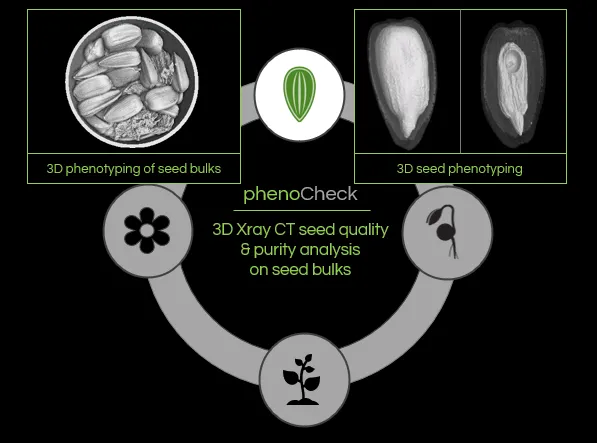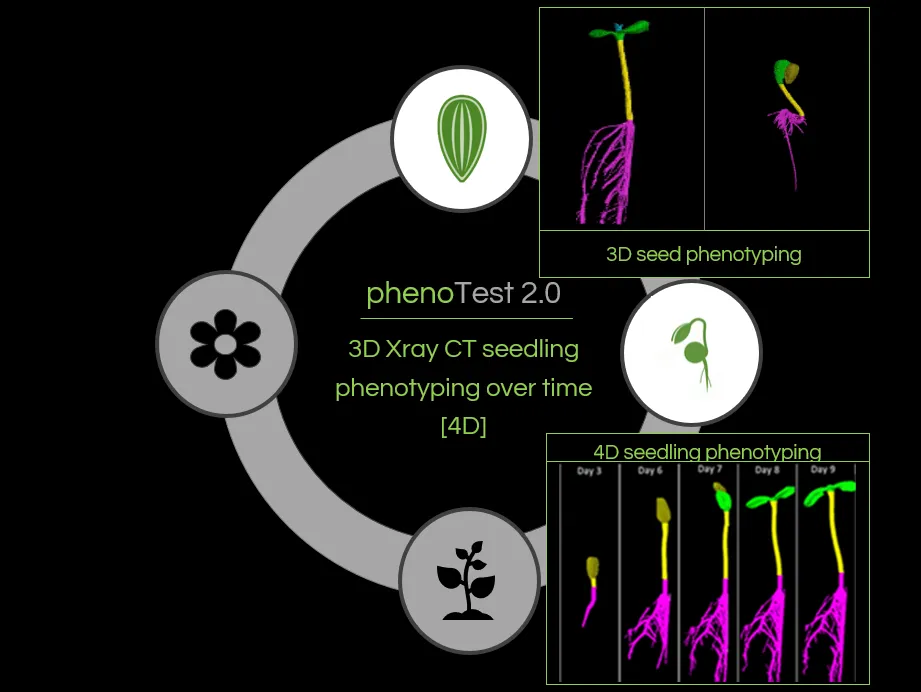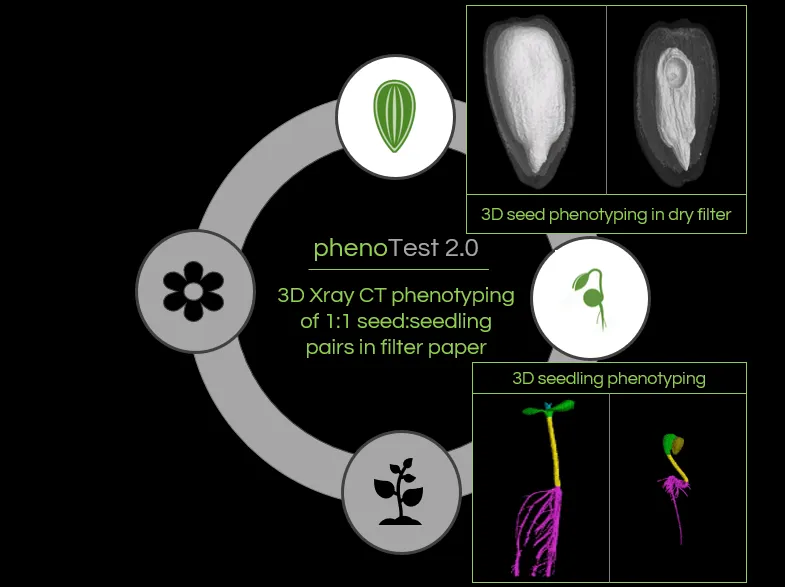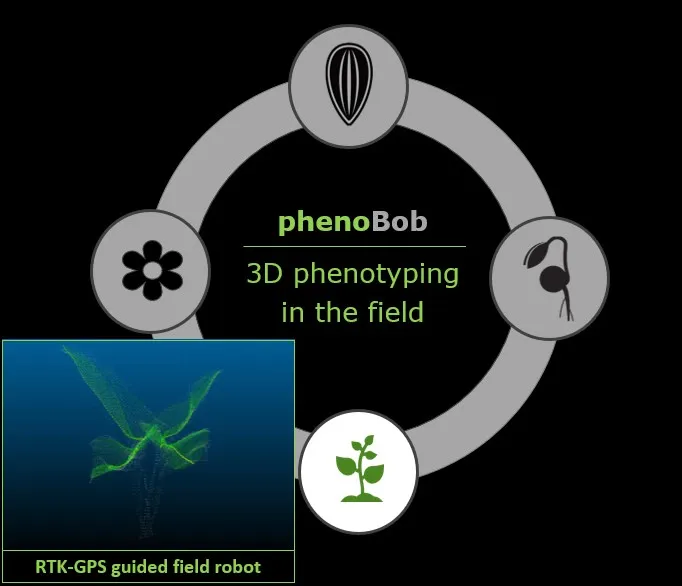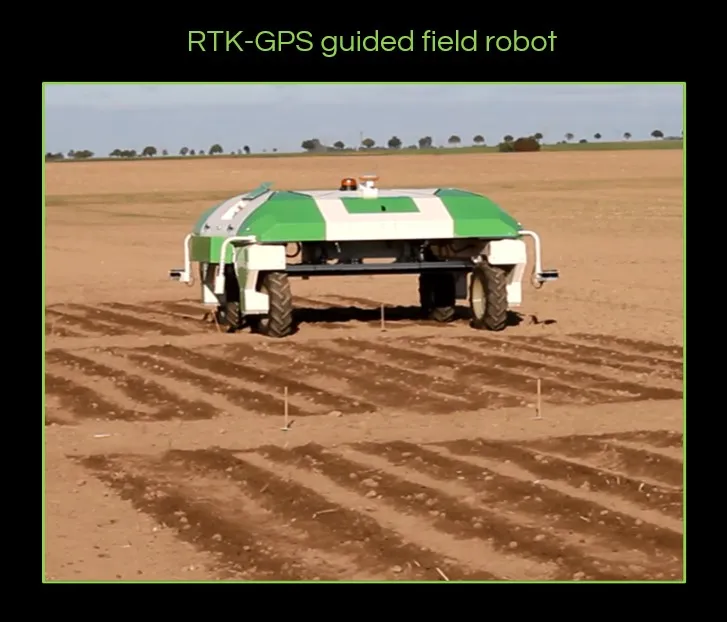Patented, industrially-validated, end-to-end technologies High-Throughput Services, Research & Systems for:
Quality Control & Sales Seed Production Seed Processing R&D & Breeding Quality Control & Sales High-throughput ground-truth 3D data of seeds & seedlings Fully automated & high throughput | Harmonize quality globally across sites | Quantify vigor & uniformity | Ensure stable seed quality
Seed Production Quick 3D Xray seed bulk checks for seed quality (issues) Detect seed quality issues early | Predict usable units after harvest | Prioritize lots for shipping & processing | Plan multiplication area early
Seed Processing In-line 3D Xray seed bulk checks for direct seed quality Reduce lead times with bulk checks | Calibrate processing machines | Minimize reprocessing | Diagnose "bad" & save "good" seeds
R&D & Breeding High-throughput measurement of seed-seedling big data Link seed & seedling quality through predictive big data | Test effects of seed treatment | Screen for early seed/seedling traits in the lab
Unlocking valueSeed
phenoCheck 3D X-Ray Phenotyping of (Bulk) Seeds Objective measuring of internal & external High-throughput seed quality & purity analysis in 3D for seed bulks within minutes Identify purity, usable seeds & seed quality issues with quick bulk checks Automatic prediction of usable units post harvest & in-line control of seed processing
phenoCheck Seed analysis & Seed processing Objective measuring of internal & external High-throughput seed quality analysis in 3D Identifying key determinants for field emergence Automatic control of seed processing
phenoTest 4D X-Ray Phenotyping of Seedlings Standardised & reproducible ground-truth data for seed quality and vigor testing across labs Quantified & documented 4D data Minimized risk of disruptions of business-critical processes by full automation Discover the phenoTest
1:1 seed to seedling phenotyping High-throughput Correlation of 3D Seed & 4D Seedling Phenotype Link 3D seed quality parameters & resulting individual seedling development in 4D Define quantitative cut- & trade-offs for usable seeds for seed production & processing Control seed quality effects & ensure stable seed quality across all processes
phenoBob 4D Field & Greenhouse Phenotyping Autonomous RTK-GPS-based navigation Real-time individual plant detection & classification in crop vs. weeds Objective tracing of field emergence & post-emergence mortality Automated quantitative analysis of phenotypic parameters
phenoScort Laser Triangulation-based 3D Sorting Patented sorting process using laser sheet-of-light for surface, size & volume of objects in 3D High-throughput at >1.6m/s of conveyor speed Sorting for internal & external 3D seed features by combined laser/2D X-Ray scanning Cleaning & sorting of seeds in multiple fractions in one step
About Us Based on 40+ years of experience in seed quality research, seed multiplication and processing, our patented technologies span the whole seed value chain from 3D Xray phenotyping for seeds & seedlings to 3D phenotyping plants in the field to a high-throughput 3D sorting machine to leverage this data. With this interconnected technology portfolio, we produce the necessary ground-truth big data of seed and plant morphological phenotypes. This ground truth data is the prerequisite to optimize all processes along the entire seed value chain from seed quality analysis and optimization, germination and vigor testing, seed processing, sales decisions and breeding for optimal yields and stress relevance - because we can only optimize what we can objectively measure. Developed by our Founder at Strube D&S in cooperation with the Fraunhofer IIS, our solutions have been validated and are in daily internal industrial use for many years. phenoLytics will make these revolutionary technologies available and accessible for all crops and the entire industry. Our mission is to drive a transformation in how seeds and plants are optimized for best yields and stress tolerance to support sustainable food production for a growing global population. With our experienced R&D and implementation partners, we not only provide research services, but offer highly customized systems, implemented as turnkey solutions with the consulting services on how to make the best use of the data.
Dr. Johannes Wolff
Founder, CEO
Leading Operations & BD
Dr. Antje Wolff
Founder
Leading R&D
Dr. Hans Bethge
R&D Project Lead
Dr. Joachim Schneider
Business Strategy
Ex-CEO Bayer Vegetable Seeds
Dr. Felix Porsch
Technology Development
Ex-Group Leader Fraunhofer IZFP
Bright Enogieru Osatohanmwen
Data Science, Machine Learning
Dr. Andreas Büchse
Machine Learning & Biostatistics
Consultant, > 25 years of industry experience
Immo Hellwig
IT & Digital
Katja Wegner
Office Administration
FAQs
General question
:
Which services does phenoLytics offer?
Apart from developing and providing turn-key systems, phenoLytics also offers services, contract research and consultancy. Our service offer covers: A) 4D phenotyping of flowers, seeds and seedlings, B) Documented germination and vigor testing, C) Contract research for seed quality and processing optimisation, GWAS, marker identification, seed treatment screening etc, D) Proof-of-concept studies for new applications and customization for potential system purchases. Our customers span both the public research organization and the industry, from small and large multinational breeders, seed producers and processors to seed treatment and enhancement firms to research institutes, universities and Genebanks.
General question
:
What is SeedTelligence?
SeedTelligence is our joint brand with PhenoKey (as automation & implementation experts) and the Fraunhofer IIS (as technology development leaders) under which we are jointly commercializing our end-toi-end technology portfolio. phenoytics acts contributes the technology protfolio, leads R&D and accompanies every implementation as application exerts to make the most off the data for each customer.
General question
:
What is your interaction with PhenoKey?
PhenoKey is our exclusive manufacturing, implementation and marketing partner. With the joint brand SeedTelligence, we jointly market all our end-to-end technologies together. PhenoKey brings an unparalleled international expertise and experience in providing turnkey solutions to clients, including automation, implementation, certification and integration in existing processes and IT infrastructures. PhenoKey perfectly complements phenoLytics’ R&D focus and allows us to implement and support our technology globally.
General question
:
What is your interaction with the Fraunhofer Institute?
The Fraunhofer Society is the largest public research organization for applied research in Europe and one of the most renowned organizations in the world, enabling small firms like ours access to world class researchers and infrastucture in specialized field. All of our technologies have been developed by our Founder Dr. Antje Wolff over the last >25 years together with the Fraunhofer Institutes IIS and IZFP for the breeding company Strube D&S. phenoLytics continues this well established and highly effective partnership by relying on the Fraunhofer IIS EZRT who are experts in Xray systems for both hardware and software development, including our (AI) algorithms for different plant species and applications. This close partnership allows us to access cutting edge, world-leading expertise in these areas, including AI training, to offer customized solutions for a broad range of customer needs and challenges. The Fraunhofer IIS has recently opened a new 2000m² phenotyping hub at which our technologies (including the phenoTest 2.0) are implemented and where also large plants in soil can be 3D Xray phenotyped, allowing to phenotype across the entire grwoth process from seed to seedling to adult plant and to flower/fruit with 3D Xray CT at a high throughput.
General question
:
Can systems be adapted to meet specific requirements?
Yes, this is an integral part of our work. For clients interested in purchasing a system, we always first carry out a proof-of-concept study to make sure that we can deliver what the customer needs and wants. Together with our manufacturing and implementation partner PhenoKey, we will customize and adapt every system to the client’s requirements in terms of software, hardware, degree of automation and throughput, to integrate a turn-key system seamlessly into existing processes and infrastructure.
General question
:
Can the systems be inspected in use?
The phenoCheck, phenoTest and phenoScort are industrially-validated and run in daily operations for many years at a German breeding company. You are very welcome to visit and to see the systems in action. Additionally, the phenoTest 2.0 system is implemented at a new 2000m² phenotyping hub at our partner, the Fraunhofer IIS, where we are now able to offer 3D Xray CT phenotyping services across the entire growth cycle from seed to seedling to plants in soild and flowers/fruits. Just shoot us a message to schedule a visit and meeting.
General question
:
Where is morphological phenotypic data needed?
Globally reproducible and quantitative morphological phenotypic big data along the entire development from seed to seedling to plant in the field is the prerequisite ground truth data to research and optimize seeds and plants: because we can only optimize, what we can reliably measure! This ground truth of a seed or plant phenotype is also necessary to effectively leverage and calibrate other indirect phenotypic information such as color, NIR, chlorophyl as well as (epi-)genomic data on phenotype-genotype links. However, current morphological phenotyping technologies still come with many limitations and constraints in terms of labor, throughput, standardization and data quality. We believe that our technologies are a game changer to provide and leverage this 3D big phenotypic data of the mrophological phenotype (ground truth) of seeds and plants to guide, digitalize and optimize all processes along the seed value chain.
phenoTest
:
What are the advantages of 3D Xray?
3D Xray CT is the only physical method known to: A) resolve internal/hidden structures (e.g., seed organs or roots in medium), B) produce high-resolution 3D morphological phenotypic data, C) to measure real biomass rather than indirect proxies, D) non-destructively follow the development process from a seed to the plant in 3D over time (i.e., in 4D), E) at a high throughput and with full automation. phenoLytics holds the process patents to use 3D Xray to phenotype seeds and germinating seedlings across the germination process.
phenoTest
:
What crops can the phenoTest be used for?
To date, we have tested over 80 plant species, from fine grasses to forestry seeds, and have not found any limitations. If we can detect the seedling with sufficient resolution, we can segment and measure it, universally for any plant.
phenoTest
:
What degree of automation is possible?
The systems can be integrated into climate chambers, automatically and autonomously feeding containers for measurement to the Xray system which allows to run the system in fully-automated 24/7 operations. Sowing and watering can be automated, too. The system integration can be modular, starting with no/limited automation, which can later be upgraded. Even with a lower degree of automation, the system can be supervised by a single person. This greatly reduces operational costs and labor dependency. Importantly, this minimises the vulnerability to disruptions of business-critical processes, such as germination testing and seed certification, as the COVID pandemic and the current labor shortages are strikingly demonstrating.
phenoTest
:
What solutions do you offer for seed phenotyping?
3D Xray CT allows to non-destructively capture and measure the external & internal phenotypes of seeds, including all seed organs. Depending on the application, seeds can be phenotyped in two set-ups: A) phenoCheck for seed bulks: 3D Xraying containers with seed bulks and reconstructing, isolating & measuring each seed in 3D in quasi-real time, at a throughput of hundreds of seeds/min. With a resolution of <50μm, even small grass seeds can be reconstructed, isolated and measured in 3D. B) phenoTest 2.0 for seed phenotyping in filter paper: With the phenoTest 2.0 (developed together with PhenoKey & Fraunhofer IIS EZRT), it is niw possible to 3D phenotype the seeds in dry filter paper, before germinating them to seedlings after watering. For both analysis streams, seeds will be: A) Automatically isolated from other seeds or the paper by an AI algorithm, B) All internal seed organs will be automatically segmented, C) All external & internal features will be measured in 3D such as seed & embryo volume, filling degree etc … everything that can be visually segmented, can be automatically measured! This allows to automatically quantify the seed quality of each individual seed, including filling degree, underdevelopments, damages & defects. The data output is measurement values for each seed (or averages for a seed lot) at thousands of such datasets per hour which can be 1:1 linked to the phenotype of the seedling growing from each seed.
phenoTest
:
Do images need to be analysed by staff to get phenotypic data?
No, images of segmented seedlings only serve to check segmentation results and may be used for visualisation and documentation purposes towards end customers. Relevant internal and external seed and seedling organs such as embryo, radicle, hypocotyl or cotyledon volume, surface areas and length and directions of growth will be automatically measured in 3D, or over the time course in 4D, for each individual seedling. The operator will usually only look at the data file that the systems outputs for each sample. By setting specific thresholds, e.g. cut-off parameters for normal or abnormally germinated, the system will automatically classify plants according to quantitative and globally reproducible data, while providing big data for research on a single seedling basis. In case of a system purchase/implementation, all data will be stored locally on site and proprietary to the user.
phenoTest
:
How do you avoid that the seeds fall down in the vertical filter paper?
phenoLytics has developed a protected fixation ring that holds seeds in place without impacting the germination process.
phenoTest
:
Can sowing be automated?
Automatic sowing is under development, with the potential to integrate further seed sensor systems at this stage, and can be provided together with automatic watering for fully automated and integrated operations. However, sowing can be done easily by a trained employee who can also act as the system supervisor.
phenoScort
:
What are the advantages of combined 3D Laser/ 2D Xray sorting?
The phenoScort uses patented laser-triangulation to capture the 3D surface structure of each object. For this, a laser line is projected on the conveyor and cameras detect the deflection of this laser line from which the 3D structure and surface of each object can be reconstructed with very high reliability and sensitivity. This 3D information is then used to classify the seeds based on the 3D parameters such as volume, length, height and surface ondulation according to pre-defined thresholds within milliseconds. The seeds are then blown out by multiple air valve banks in different fractions, allowing to clean from impurities, size grade and sort in a single step in multiple fractions at an industrial throughput. The combination with 2D Xray (i.e, the sorting for the combination of 3D external and 2D internal features) is currently under development. 3D sorting, especially in combination with 2D Xray, allows to sort for parameters that cannot be effectively seperated with conventional processing machines such as gravity tables and sieves. Essentially, small differences in the form or surfaces of seeds can be distinguished and seperated, allowing to sort seeds or impurities that are otherwise similar in size, weight and dimensions. This sorting decision can be steered by 3D Xray CT data, training the AI sorting algorithms on quality-labelled 3D seed data in a direct self-learning integration of both technologies. We are also exploring the use of 3D-Xray (Gantry CT) for seed sorting, but this is currently technically not yet feasible at the necessary throughput.
phenoScort
:
What is the throughput in industrial use?
Currently, four sorters are in daily operations since many years at a breeding company. The current throughput for these systems is about 1.6m/s of conveyor speed or about 300,000 objects/min for sugar beet. The advantage of laser triangulation is that the breadth of the conveyor belt and thus the amount of objects scanned per second can be easily scaled, allowing for super high-throughput sorting. The phenoScort currently under development with combined 3D laser (external seed parameters) + 2D Xray (internal seed quality) will most likely operate at similar or even higher speed and thus throughput (depending on seed size).
General question
:
What are long-term developments you are working on?
We always explore combinations with other sensor systems, such as combining 3D Xray CT morphological data with NMR spectral information to link chemical composition with structural/morphological imaging data. This combination could potentiate their respective advantages, while minimizing their respective shortcomings, to link physiological to phenotypic information, for use, on a single seed-level, both for phenotyping as well as sorting. We are also actively exploring the possibilities of GantryCT, i.e., Computed Tomography of moving objects, for 3D phenotyping seeds, plants, fruits and tissue cultures in “flow-through”, e.g., on a conveyor, at an even higher throughput then what we are currently achieving. We are also exploring GantryCT based sorting, allowing to sort for objects with 3D Xray CT. However, this is currently not technically viable at the required resolution, throughput and price, which is why we are pursuing the combination of 3D Laser triangulation with 2D Xray for our conveyor-based phenoScort.



